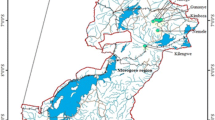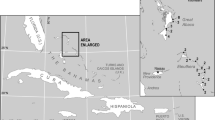Abstract
Tropical dry forests have been reduced to less than 0.1% of their original expanse on the Pacific side of Central America and are considered by some to be the most endangered ecosystem in the lowland tropics. Plots 1000 m2 were established in seven tropical dry forests in Costa Rica and Nicaragua in order to compare levels of species richness to other Neotropical dry forest sites and to identify environmental variables associated with species richness and abundance. A total of 204 species and 1484 individuals ≥ 2.5 cm were encountered. Santa Rosa National Park was the richest site with the highest family (33), genera (69), and species (75) diversity of all sites. Species richness and forest structure were significantly different between sites. Fabaceae was the dominant tree and shrub family at most sites, but no species was repeatably dominant based on number of stems in all fragments of tropical dry forest. Central American dry forests had similar species richness when compared to other Neotropical forests. There was no correlation between forest cover within reserves, or precipitation and plant species richness. There was a significant correlation between anthropogenic disturbance (intensity and frequency of fire, wood collection, grazing) and total species richness, tree and shrub species richness, and liana abundance. These results suggest controlling levels on anthropogenic disturbance within reserves should be a high priority for resource managers in Central America. Further research in forest fragments which examine individual and a combination of disturbance agents would help clarify the importance of anthropogenic disturbance on species richness and abundance.
Similar content being viewed by others
References
Arriaga, L. & León, J. L. 1989. The Mexican tropical deciduous forest of BajaCalifornia Sur: A floristic and structural approach. Vegetatio 84: 45–52.
Ashton, P.S. 1969. Speciation among tropical forest trees: Some deductions in light of recent evidence. Biol. J. Linnean Soc. 1: 155–196.
Brown, A.D., Chalukian, S.C. & Malmierca, L.M. 1985. Estudio floristico-estructural de un sector de selva semidecidua del Noreste Argentina 1. Composicion floristica, densidad, y diversidad. Darwiniana 26: 27–41.
Brown, K.S. & Brown, G.G. 1992. Habitat alteration and species loss in Brazilian forests. Pp. 119–142. In: Whitmore, T.C. & Sayer, J.A. (eds), Tropical deforestation and species extinction. Chapman and Hall, London.
Budowski, G. 1966. Fire in tropical lowland areas. Proceedings of the Annual Tall Timbers Fire Ecol. Conf. 5: 5–22.
Budowski, G. 1970. The distinction between old secondary and climax speciesin tropical Central American lowland forests. Tropical Ecol. 2(1): 44–48.
Bullock, S. H. 1985. Breeding systems in the flora of a tropical deciduous forest in Mexico. Biotropica 17: 287–301.
Burger, W. 1971. Flora Costaricensis. Field Museum of Natural History. Volume 1–40.
Clinebell, R.R., Phillips, O.L., Gentry, A.H., Starks, N. & Zuuring, H. 1995. Prediction of neotropical tree and liana species richness from soil and climatic data. Biod. Cons. 4: 56–90.
Connell, J.H. 1978. Diversity in tropical rain forests and coral reefs. Science 199: 1302–1310.
Daubenmire, R. 1972. Phenology and other characteristics of tropical semi-deciduous forest in northeastern Costa Rica. J. Ecol. 60: 147–170.
Dodson, C.H. & Gentry, A.H. 1992. Florula de Capeira. Banco Nacional de Ecuador, Quito.
Fensham, R.J. 1995. Floristics and environmental relations of inland dry rainforest in north Queensland, Australia. J. Biog. 22: 1047–1063.
Flora de Nicaragua Project. 1998. Flora de Nicaragua. Missouri Botanical Gardens, unpublished manuscript.
Foster, R.B. 1990. Heterogeneity and disturbance in tropical vegetation. Pp. 75–92 In: Soule, M.E. & Wilcox, B.A. (eds), Conservation biology: an evolutionary-ecological perspective. Sinauer Associates, Sunderland.
Gentry, A.H. 1982. Patterns of Neotropical plant species diversity. Evol. Biol. 15: 1–84.
Gentry, A.H. 1988. Changes in plant community diversity and floristic composition on environmental and geographical gradients. Ann. Missouri Bot. Garden 75: 1–34.
Gentry, A.H. 1991. The distribution and evolution of climbing plants. Pp. 3–42. In: Putz, F.E. & Mooney, H.A. (eds), The biology of vines. Cambridge University Press, Cambridge.
Gentry, A.H. 1995. Diversity and floristic composition of neotropical dry forests. Pp. 146–194. In: Bullock, S.H., Mooney, H.A. & Medina, E. (eds) Seasonally dry tropical forests. Cambridge University Press, Cambridge.
Gerhardt, K. & Hytteborn, H. 1992. Natural dynamics and regeneration methods in tropical dry forests: An introduction. J. Veg. Sci. 3: 361–364.
Gessner, F. 1956. Wasserhaushalt der Epiphyten und Lianen. Pp. 915–950. In: H. Ruhland, H. (ed.), Handbuch der pflanzenphysiologie. Vol. III, Springer-Verlag, Berlin.
Heybrock, G. 1984. Der Tayrona-Trockenwald Nord-Kolumbiens. Eine Okosystemstudie unter besonderer Berucksichtigung von Biomasse und Blattflachenindex (LAI). Giessener Geographische Schriften 55: 1–104.
Heywood, V.H., Mace, G.M., May, R.M. & Stuart, S.N. 1994. Uncertainties in extinction rates. Nature 368: 105.
Holdridge, L.R., Grenke, W.C., Hatheway, W.H., Liang, T. & Tosi, J.A., Jr. 1971. Forest environments in tropical life zones. Pergamon Press, New York.
Hubbell, S.P. 1979. Tree dispersion, abundance and diversity in a tropical dry forest. Science 203: 1299–1309.
INETER (Instituto Nicaragüense de Estudios Territoriales) 1997. Anuario Meteorologico:1996. INETER, Managua.
Janzen, D.H. 1986. Guanacaste national park: Tropical ecological and cultural restoration. Editorial Universidad Estatal A Distancia, San Jose.
Janzen, D.H. 1988a. Tropical dry forests: The most endangered major tropical ecosystem. Pp. 130–137. In: Wilson, E.O. (ed.), Biodiversity. National Academic Press, Washington, D.C.
Janzen, D.H. 1988b. Management of habitat fragments in a tropical dry forest: Growth. Ann. Missouri Bot. Garden 75: 105–116.
Janzen, D.H. & R. Liesner. 1980. Annotated checklist of lowland Guanacaste Province, Costa Rica, exclusive of grasses and nonvascular cryptograms. Brenesia 18: 15–90.
Jayasingam, T. & Vivekanantharaja, S. 1994. Vegetation survey of the Wasgomuwa National Park, Sri Lanka: analysis of the Wasgomuwa Oya Forest. Vegetatio 13(1): 1–8.
Keel, S., Gentry, A.H. & Spinzi, L. 1993. Using vegetation analysis to facilitate the selection of conservation sites in eastern Paraguay. Cons. Biol. 7(1): 66–75.
Kramer, E.A. 1997. Measuring landscape changes in remnant tropical dry forests. Pp. 386–399. In: Laurance, W.F. & Bierregaard, R.O., (eds), Tropical forest remnants. The University of Chicago Press, Chicago.
Lerdau, M., Whitbeck, J. & Holbrook, N.M. 1991. Tropical deciduous forest: Death of a biome. Trends Ecol. Evol. 6(7): 201–202.
Lott, E.J., Bullock, S.H., & Solís-Magallanes, J.A. 1987. Floristic diversity and structure of a tropical deciduous forest of coastal Jalisco. Biotropica 19: 228–235.
Maass, J.M. 1995. Conversion of tropical dry forest to pasture and agriculture. Pp. 399–422. In: Bullock, S.H., Mooney, H.A. & Medina, E. (eds), Seasonally dry tropical forests. Cambridge University Press, Cambridge.
Maldonado, T., Bravo, J., Castro, G., Jimenez, Q. & Saborío, O. 1995. Evaluación ecológica rápida del region Tempisque, Guanacaste, Costa Rica. Fundación Neotrópica, San Jose.
MacArthur, R.H. & Wilson, E.O. 1967. The theory of island biogeography. Princeton University Press, Princeton.
Medina, E. 1995. Diversity of life forms of higher plants in neotropical dry forests. Pp. 221–242. In: Bullock, S.H., Mooney, H.A. & Medina, E. (eds), Seasonally dry tropical forests. Cambridge University Press, Cambridge.
Murphy, P.G. & Lugo, A.E. 1986a. Ecology of tropical dry forest. Annual Rev. Ecol. Syst. 17: 67–88.
Murphy, P.G. & Lugo, A.E. 1986b. Structure and biomass of a subtropical dry forest in Puerto Rico. Biotropica 18: 89–96.
Murphy, P.G. & Lugo, A.E. 1995. Dry forests of Central America and the Caribbean. Pp. 9–34. In: Bullock, S.H., Mooney, H.A. & Medina, E. (eds), Seasonally dry tropical forests. Cambridge University Press, Cambridge.
Phillips, O.L. & Raven, P.H. 1996. A strategy for sampling Neotropical forests. Pp. 141–165. In: Gibson, A.C. (ed.), Neotropical biodiversity and conservation. Occasional publications of the Mildred E. Mathias Botanical Garden, Los Angeles.
Pickett, S.T. & White, P.S. 1985. The ecology of natural disturbance and patch dynamics. Academic Press, New York.
Pielou, E.C. 1977. Mathematical ecology. John Wiley and Sons, New York.
Pimm, S.L., Jones, H.L., & Diamond, J. 1988. On the risk of extinction. Am. Nat. 132: 757–785.
Putz, F.E. 1984. The natural history of lianas on Barro Colorado island, Panama. Ecology 65: 1713–1724.
Ribichich, A.M. & Protomastro, J. 1998. Woody vegetation structure of xeric forest stands under different edaphic site conditions and disturbance histories in the Biosphere Reserve 'Parque Costero del Sur', Argentina. Plant Ecol. 139: 189–201.
Sabogal, C. 1992. Regeneration of tropical dry forests in Central America, with examples from Nicaragua. J. Veg. Sci. 3: 407–416.
Savage, M. 1992. Germination of forest species under an anthropogenic vine mosaic in Western Samoa. Biotropica 24(3): 460–462.
Shaffer, M.L. 1981. Minimum population size for species conservation. BioScience 31: 131–134.
Simberloff, D.S. 1986. Are we on the verge of a mass extinction in tropical rainforests? Pp. 165–180. In: Elliot, D.K. (ed.), Dynamics of extinction. Wiley-Interscience, New York.
Sukumar, R., Dattaraja, H.S., Suresh, H.S., Radhakrishnan, J., Vasudeva, R., Nirmala, S. & Joshi, N.V. 1992. Long-term monitoring of vegetation in a tropical deciduous forest in Mudumalai, southern India. Current Sci. 62(9): 608–616.
Swaine, M.D. 1992. Characteristics of dry forest in West Africa and the influence of fire. J. Veg. Sci. 3: 365–374.
Swaine, M.D., Lieberman, D. & Hall, J.B. 1990. Structure and dynamics of a tropical dry forest in Ghana. Vegetatio 88: 31–51.
Turner, I.M., Tan, H.T.W., Wee, Y.C., bin Ibrahim, A., Chew, P.T. & Corlett, R.T. 1994. A study of plant species extinction in Singapore: Lessons for the conservation of tropical biodiversity. Cons. Biol. 8: 705–712.
van Wyngaarden, W. 1988. Low-level aerial survey techniques. Pp. 209–213. In: Küchler, A.W. & Zonneveld, I.S. (eds), Vegetation analysis, Vol. 2. Kluwer Academic Publishers, Dordrecht.
Veblen, T.T. 1982. The effects of introduced wild animals on New Zealand forests. Ann. Assoc. Am. Geog. 72: 372–397.
Veblen, T.T., Kitzberger, T. & Lara, A. 1992. Disturbance and forest dynamics along a transect from Andean rain forest to Patagonian shrubland. J. Veg. Sci. 3: 507–520.
Whitmore, T.C. 1997. Tropical forest disturbance, disappearance, and species loss. Pp. 3–12. In: Laurance, W.F. & Bierregaard, R.O., (eds), Tropical forest remnants. The University of Chicago Press, Chicago.
Author information
Authors and Affiliations
Rights and permissions
About this article
Cite this article
Gillespie, T.W., Grijalva, A. & Farris, C.N. Diversity, composition, and structure of tropical dry forests in Central America. Plant Ecology 147, 37–47 (2000). https://doi.org/10.1023/A:1009848525399
Issue Date:
DOI: https://doi.org/10.1023/A:1009848525399




